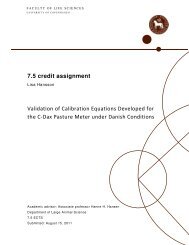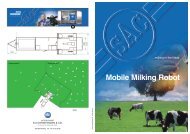Innovative Technology and Sustainable Development of Organic - 1.
Innovative Technology and Sustainable Development of Organic - 1.
Innovative Technology and Sustainable Development of Organic - 1.
Create successful ePaper yourself
Turn your PDF publications into a flip-book with our unique Google optimized e-Paper software.
validation, using an iterative process involving stakeholders (Borch, 2007). Impact assessments on<br />
known technologies, which have not been implemented, have also been performed (Sørensen et al.,<br />
2005). In a process <strong>of</strong> extrapolating test-prototypes results to agricultural systems, assessment on<br />
economic consequences (revenue, labour) was performed. Based on previous examples <strong>of</strong> detrimental<br />
impact, a perpetual evaluation <strong>of</strong> new technologies when implemented in organic practice is required,<br />
to avoid externalities on environmental or social aspects. Challenge lies in selecting <strong>and</strong> agreeing on<br />
relevant issues to assess, incorporating the holistic approach <strong>of</strong> the organic principles <strong>and</strong> making<br />
trade-<strong>of</strong>fs. In addition the conclusion <strong>of</strong> foresight technology research can be quoted; ‘it is necessary to<br />
define clear sustainability criteria <strong>and</strong> matching indicators. Only in this way can technological<br />
development be evaluated <strong>and</strong> prioritized’ (Borch, 2007). Compliance <strong>of</strong> the sustainability criteria to<br />
organic principles is necessary in this process.<br />
An example <strong>of</strong> an innovative technology in organic dairy production is the use <strong>of</strong> an automatic<br />
milking system (AMS). In 2007, 10% <strong>of</strong> the organic farms in Denmark used an AMS (Danish<br />
Agricultural Advisory System), whereas in the Netherl<strong>and</strong>s this was around 8.7% (Smolders, 2008). Its<br />
introduction occurred relatively quickly during the last decade. The economic, environmental <strong>and</strong><br />
social consequences <strong>of</strong> introduction <strong>of</strong> AMS technology in organic dairy farming, however, were never<br />
assessed. Integrating EES issues into technology assessments <strong>and</strong> exploring future situations, is quite a<br />
challenge. Disciplinary impact analyses are dominant, <strong>and</strong> <strong>of</strong>ten research prefers to investigate present<br />
situations rather than referring to the unsure foresight <strong>of</strong> the future.<br />
In literature, a framework has been described, that could be used to evaluate the economic,<br />
environmental <strong>and</strong> social consequences <strong>of</strong> the introduction <strong>of</strong> AMS (Mollenhorst et al., 2006). Other<br />
methods have been developed to explore future development (Sonesson et al., 2005). Both methods<br />
implicate use <strong>of</strong> stakeholders, which seems necessary for technology assessment. The framework<br />
described by Mollenhorst et al. (2006) consists <strong>of</strong> the following steps:<br />
<strong>1.</strong> Identification <strong>of</strong> stakeholders <strong>and</strong> description <strong>of</strong> the problem situation.<br />
2. Determination <strong>of</strong> the goals <strong>of</strong> production <strong>and</strong> relevant economic, ecological <strong>and</strong><br />
societal (EES) issues.<br />
3. Translation <strong>of</strong> the selected issues into quantifiable indicators for sustainability.<br />
4. Final assessment <strong>of</strong> the contribution <strong>of</strong> a technology to sustainable development based<br />
on indicator quantification in step (3)<br />
5. Communication <strong>and</strong> dissemination <strong>of</strong> results to stakeholders, review <strong>of</strong> the<br />
process, <strong>and</strong> evaluation <strong>of</strong> results based on the original problem definition.<br />
In conclusion, the importance <strong>of</strong> a holistic assessment <strong>of</strong> innovative technology is evident <strong>and</strong><br />
concerning implementation on organic farming, the necessity is extra important due to specific defined<br />
goals on environmental <strong>and</strong> societal level (IFOAM, 2008).<br />
<strong>1.</strong>3 Objectives <strong>of</strong> the research<br />
The general objective <strong>of</strong> the PhD assignment was to assess the contribution <strong>of</strong> new technologies to the<br />
sustainable development <strong>of</strong> organic dairy farming, using AMS as a case for the present technological<br />
situation.<br />
To accomplish this general objective, the framework as described in <strong>1.</strong>2 was used. This resulted in<br />
the following research questions;<br />
Thesis Frank W. Oudshoorn 13




